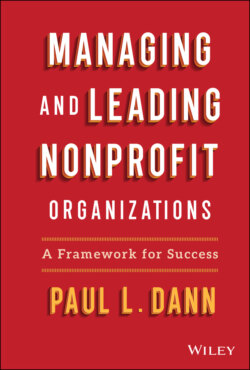Читать книгу Managing and Leading Nonprofit Organizations - Paul L. Dann - Страница 20
Sharpen Your Saw
ОглавлениеThere is an old proverb about a man who was working furiously to saw down a tree. A farmer passing by could not help but notice the man, who was covered head to toe in sweat and nearing collapse. The farmer asked the man how long he had been at the task of sawing down the tree. The man replied that he had been on the job for hours and thought that the tree must be the hardest of wood. As the farmer leaned in, he saw that the teeth on the saw were dull and nearly undetectable. “Maybe you should sharpen your saw,” the farmer commented. The man looked dumbfounded as he had only considered how remarkably hard the wood was on this tree, not the state of his saw.
Leadership tools, like any tool, require sharpening. You may have developed a complete toolbox for your leadership practice, but have you taken the time to ensure that your tools are well maintained? If not, you will find yourself like the gentleman in the proverb, working all day to no avail.
Sharpening your saw from a leadership perspective can involve a wide array of activities. Attending trainings is one way to fine‐tune your capacity to use your leadership practice tools. Reading and exposing yourself to emergent ideas as well as tried‐and‐true notions of effective leadership practice can also serve as an important source for sharpening your proverbial saw. Find a community to talk about leadership and take time to read about leadership practice. There are any number of leadership groups and forums that exist on multiple platforms—LinkedIn, for example—as well as various leadership associations, such as ILA, the International Leadership Association. Be active and pursue membership in these forums so that you ensure that your leadership development is something that is ongoing.
You can also pursue more informal ways to develop your leadership practice. For example, I have a group of colleagues who meet monthly to share ideas about leadership and management practice. This group has become invaluable and serves a function that is helpful well beyond our monthly meetings by making it possible to reach out and connect about specific challenges between meetings.
Another way to sharpen your saw is to develop your ability to be mindful and fully present in your leadership practice. Mindfulness practice has become an important habit for many successful leaders. We are busy within our culture, constantly going somewhere and always doing something. Taking time to slow down, stop, and be in the moment helps you to build your capacity to be reflective. If you can calm the noise in your head that is created by our frenetic pace, then you will be better able to exercise leadership practice that supports your efforts. In the Appendix of this book, you will find five mindfulness practices that are both easy and simple to practice. My go‐to mindfulness practice from this list is mindful breathing. It is an activity that I can do in just a few minutes, sitting at my desk or just before I enter a meeting, that helps to enhance my mindfulness and ultimately my effectiveness.
You might feel that you do not have time to pursue a mindfulness practice or that you do not see why this would be important. It is important to understand that research has shown the efficacy of mindfulness. Chin et al. (2019), for example, underscore how mindfulness is associated with stress reduction. Similarly, Bell's (2015) research shows that people who are more mindful have better physical and mental health, including less anxiety and lower blood pressure. Each of the findings here underscore how mindfulness can help you build your leadership capability. The importance of mindfulness in leadership is also underscored by the work of Tohme and Joseph (2020), whose research identified a positive correlation between authenticity, mindfulness, and emotional intelligence.
Taken together these activities can help to ensure that you continually refine your ability to make wise use of your leadership toolbox. Do not be caught working yourself to death with dull tools. Work intentionally to enhance your leadership practice at every turn. I am confident that you will find the various activities associated with sharpening your leadership practice to be enjoyable as well as rewarding. Remember this journey is one that should be ongoing. We can and should work every day to advance our leadership skills.
